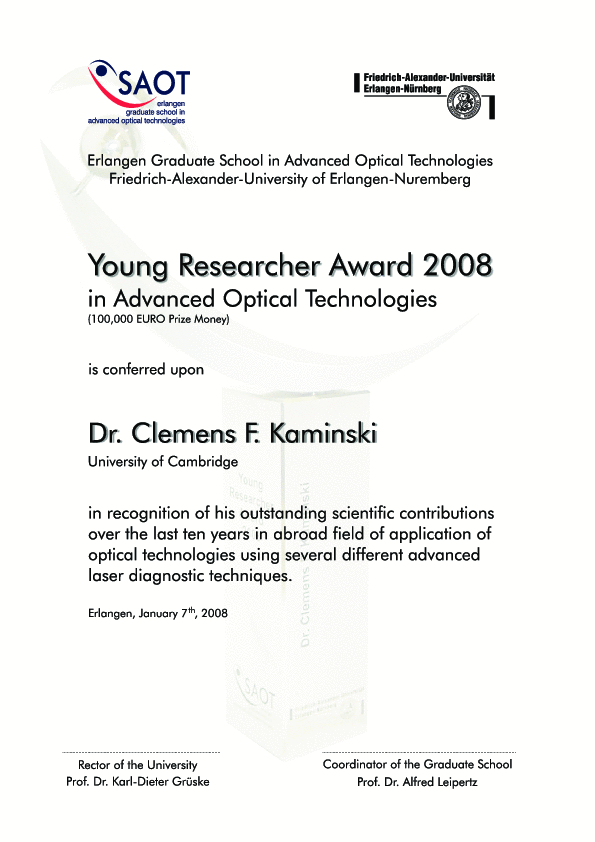Young Researcher Award
For the 13th time, the Erlangen Graduate School in Advanced Optical Technologies (SAOT) has invited young researchers to apply for the SAOT Young Researcher Award (YRA) in Advanced Optical Technologies. The 100.000 € award is open to scientists with a proven record in optics, photonics and optical technologies.
The SAOT Award Ceremony will be celebrated on July 25th, 16:00, in Lecture Hall H8, Erwin-Rommel-Straße 60, 91058 Erlangen.
Guest speaker at this year’s ceremony, where the SAOT Innovation Award and SAOT Student Awards will also be presented, is Professor James G. Fujimoto, Massachusetts Institute of Technology (MIT).
Registration
Registration closed.
Previous award winners:
Almost 100 invited guests listened to Samuel Grauer, when he introduced his research plans on July 8th 2022. The award ceremony took place in the Rudolf-Wöhrl lecture hall at the University Hospital Erlangen.
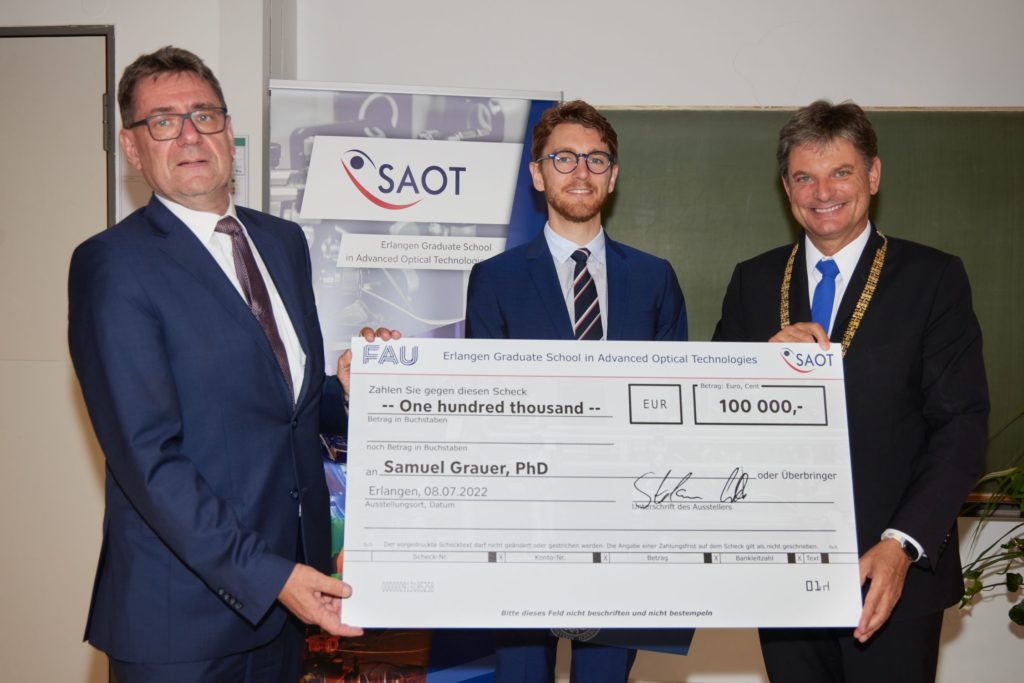
His project “Physics-Informed 4D Imaging of Turbulent Flows” will allow for insight into the complex dynamics of environmental and engineering flows like ocean currents, pollutant streams, and combustion processes. By combining time-resolved 3D absorption tomography with a physics-informed neuronal network for data analysis, he wants to close the gap between the information which can be measured by existing diagnostics and the information needed to characterize scalar mixing and reactive processes. During his stay in Erlangen, he will mainly collaborate with the Institute of Engineering Thermodynamics (LTT) and the Pattern Recognition Laboratory (LME), both located at the Faculty of Engineering at FAU.
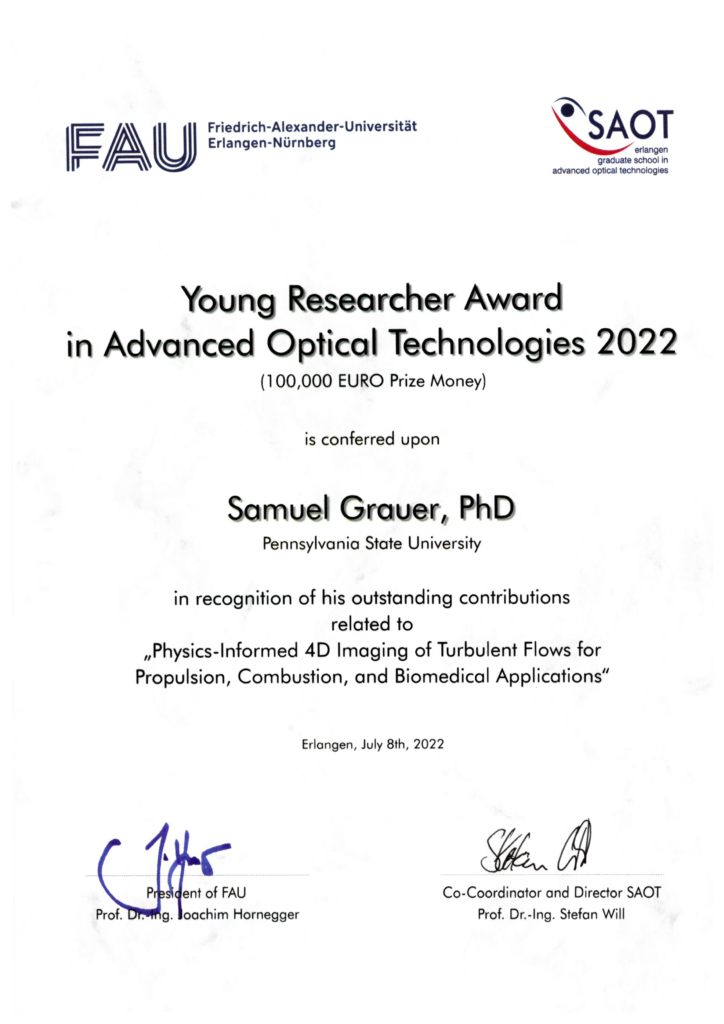
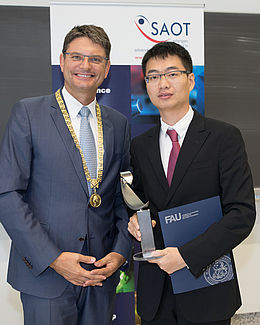
This year, the largest monetary prize awarded by Friedrich-Alexander-Universität Erlangen-Nürnberg (FAU) went to Professor Weiwei Cai, PhD, of Shanghai Jiao Tong University. Professor Cai was awarded the Young Researcher Award in Optical Technologies (YRA) by the Erlangen Graduate School in Advanced Optical Technologies (SAOT) in recognition of his outstanding work in the field of optics and optical technologies. The prize, worth 100,000 euros, comes with a year-long guest professorship at FAU.
Professor Weiwei Cai, who earned his PhD at Clemson University in the US, has been employed at Shanghai Jiao Tong University since 2015. He previously spent extensive periods at Virginia Tech in the USA, and the University of Cambridge in the UK. At FAU, he will work on improved tomographic methods for three-dimensional imaging in collaboration with researchers from the Institute of Engineering Thermodynamics (Professor Will), the Institute of Photonic Technologies (Professor Schmidt) and the Pattern Recognition Lab (Professor Maier), among others.
Professor Cai’s pioneering work on nonlinear tomographic absorption spectroscopy has implications for research in areas including combustion processes, nanoparticle synthesis and laser beam welding.
Besides Professor Cai, a number of Chinese PhD students will travel to Erlangen for prolonged research stays to work on the project alongside SAOT researchers. In addition to financing this exchange, he will use the prize money to buy special equipment for the research in Erlangen.
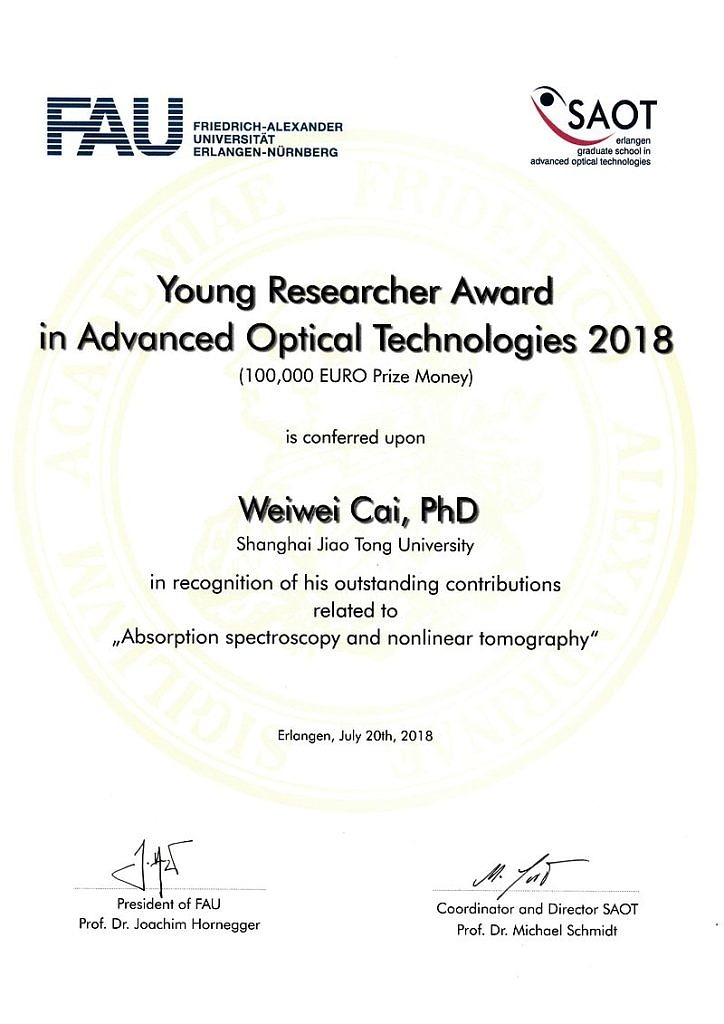
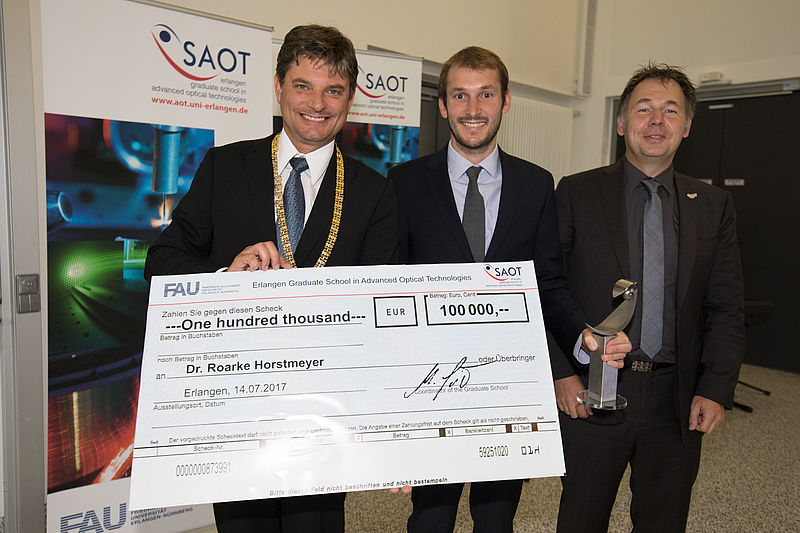
In 2017, for the tenth time, the Erlangen Graduate School in Advanced Optical Technologies (SAOT) presented the Young Researcher Award in Optical Technologies (YRA) to a young scientist with an excellent proven record in optics and optical technologies.
The 2017 laureate is Dr. Roarke Horstmeyer, Einstein International Postdoctoral Fellow at Charité Medical School and Humboldt University of Berlin. During the award celebration ceremony on July 14th, 2017, the award was conferred on him in recognition of his outstanding contributions related to “3D microscopy imaging and classification with 4Pi Ptychography”.
Dr. Horstmeyer will work on improving the achievable resolution of 3D Fourier ptychography using both reflected and transmitted light, and to explore how such an information-rich dataset may improve the accuracy of the image classification via machine learning. The first main application of this work will be aimed towards lithographic mask inspection. However, its findings will also directly apply to biological samples that both reflect and transmit light (e.g. collagen fibers, lymph nodes, or samples functionalized on semi-reflective substrates).
The expertise of Dr. Horstmeyer fits well to establish a fruitful collaboration between SAOT researchers and him. He will especially work with the group of PD Andreas Erdmann, with Prof. Sandoghar and the Nano-Optics group and Prof. Hornegger and Prof. Maier of the Pattern Recognition Lab.
As award winner he will have the status of a guest professor during his visits at the SAOT when he spends the prize money of 100,000 Euros in close collaborations with several SAOT scientists. For the next few years he will set up a small working group in Erlangen to pursue optical investigations in his area of expertise.
In his welcome address, the SAOT Coordinator and Director Professor Schmidt gave a short overview about SAOT and welcomed Dr. Horstmeyer, laureates from the past, and chosen guests.
The lecture of the academic ceremony was given by Dr. Michael Totzeck, Fellow Corporate Research and Technology, Carl Zeiss AG. The title of the lecture was „Optics and Digitalization – On the mutual reinforcement of two game-changing technologies“.
After a Laudation given by Professor Schmidt, the YRA, which includes a certificate, a trophy, and a € 100,000 check, was presented to Dr. Horstmeyer by the President of the Friedrich-Alexander-Universität, Professor Hornegger.
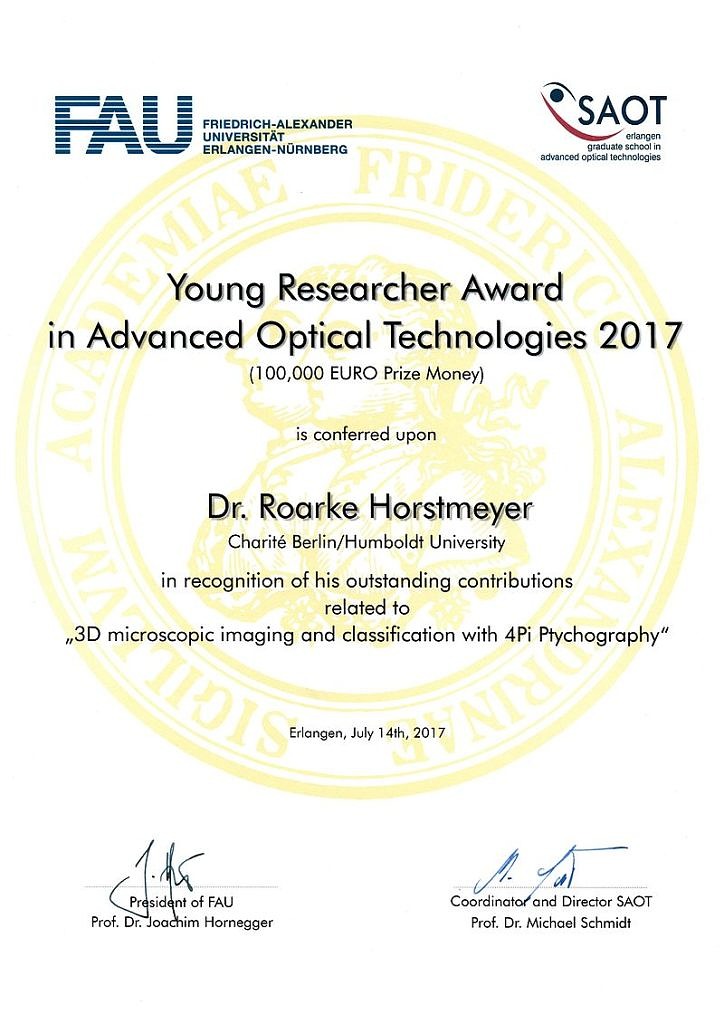
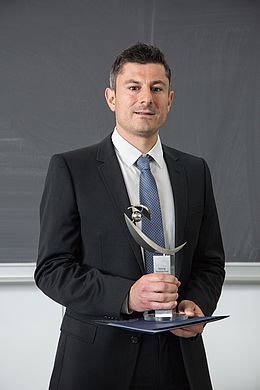
In a ceremony on 8th July 2016, the SAOT Young Researcher Award in Optical Technologies (YRA) was awarded for the ninth time to a young scientist with an excellent proven record in optics and optical technology.
The 2016 laureate is Professor Darko Zibar from the Department of Photonics at the Technical University of Denmark (DTU). The award was conferred on him in recognition of his outstanding contributions related to „Application of machine learning techniques to optical communication“.
Optical technologies have had a tremendous impact on the current communication infrastructure by enabling a high capacity data transport. This has resulted in a data explosion as the world is connected more than ever. It is expected that the global data traffic will exceed Exabits/s (1018 bit/s) in the near future. By 2020, our society will require capacities that are physically impossible to implement using current state-of-the-art optical communication technologies. In order to build future optical networks that can satisfy future capacity demands, several disciplines such as nonlinear optics, machine learning and optical fibre communication will have to be combined.
The expertise of Professor Zibar provides the foundation to establish a fruitful collaboration between SAOT researchers and him, especially in the fields of optical communication. Moreover, the idea is to initiate new research directions by exploring the machine learning techniques for optical fibre sensors and cavity opto-mechanics.
As award winner, he has the formal status of a guest professor during his time at the SAOT while utilizing is prize money of € 100,000 in close collaboration with several SAOT scientists.
In his welcome address, the SAOT Coordinator and Director Professor Schmidt gave a short overview about SAOT and welcomed Professor Zirba, laureates from the past, and chosen guests.
The lecture of the academic ceremony was given by Professor Sergei K. Turitsyn, Aston Institute of Photonic Technologies, Birmingham, UK. The title of the lecture was „Nonlinear Science of Commercial Optical Systems and Devices“.
After a Laudation given by Professor Schmidt, the YRA, which includes a certificate, a trophy, and a € 100,000 check, was presented to Professor Zirba by the President of the Friedrich-Alexander-Universität, Professor Hornegger.
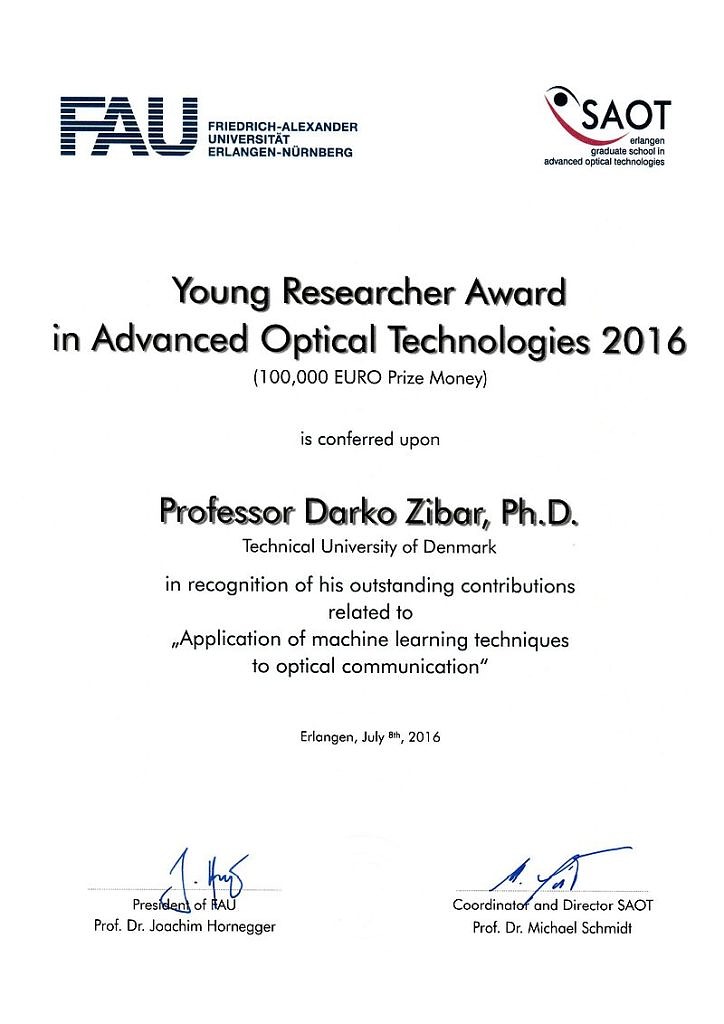
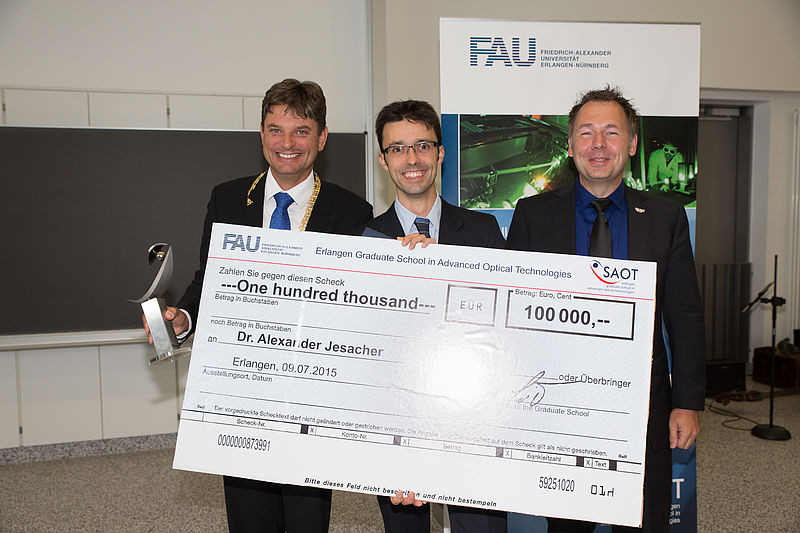
In a ceremony on 9th July 2015, the SAOT Young Researcher Award in Optical Technologies (YRA) was awarded for the eighth time to a young scientist with an excellent proven record in optics and optical technologies.
The 2015 laureate is Professor Alexander Jesacher from the Division for Biomedical Physics of the Medical University Innsbruck, Austria. The award was conferred on him in recognition of his outstanding contributions related to “Diffractive Optics in Camera-Based Scanning Microscopy”.
Jesacher’s fields of specialization are:
- Active & Adaptive optics in light microscopy
- Confocal microscopy
Harmonic generation microscopy (SHG, THG) - Coherent anti-Stokes Raman Scattering (CARS) microscopy
- Lensless imaging and digital holography
- PSF engineering
- Laser micro-fabrication
- Optical Micromanipulation
Fortunately the expertise of Professor Jesacher fits well to establish a fruitful collaboration between SAOT researchers and him. Or as he put it in his own words: “My motivation for applying was the fact that the SAOT young researcher award is an excellent opportunity for me, as it would allow me to be a part of a powerful network of expertise in optics and to broaden my knowledge in this exciting field. I also believe that my expertise would be a gain for the SAOT, since I can identify common interest but also complementary skills. I can already propose interesting research in a field which combines scanning optical microscopy with diffractive optics and I am confident that yet unknown prospects and ideas will develop during my research stay in Erlangen.”
As award winner he has the formal status of a guest professor during his visits at the SAOT when he spends his prize money of 100.000 Euros in close collaboration with several SAOT scientists.
In his welcome address the SAOT Coordinator and Director Professor Schmidt gave a short overview about SAOT and welcomed Professor Jesacher, laureates from the past and chosen guests.
The lecture of the academic ceremony was given by Professor Rafael Piestun, Director of NSF-IGERT Program in Computational Optics Sensing and Imaging at the University of Colorado, USA. The title of the lecture was “Overcoming diffraction and scattering effects: A new era in optical imaging”.
After a Laudation given by Professor Schmidt, the YRA which comprises a certificate, a trophy and a € 100.000 cheque, was presented to Professor Jesacher by the President of the Friedrich-Alexander-Universität, Professor Hornegger.
Following the acknowledgment of Professor Jesacher, the Student Award 2015 was presented by Professor Will, Co-Coordinator and Director of SAOT.
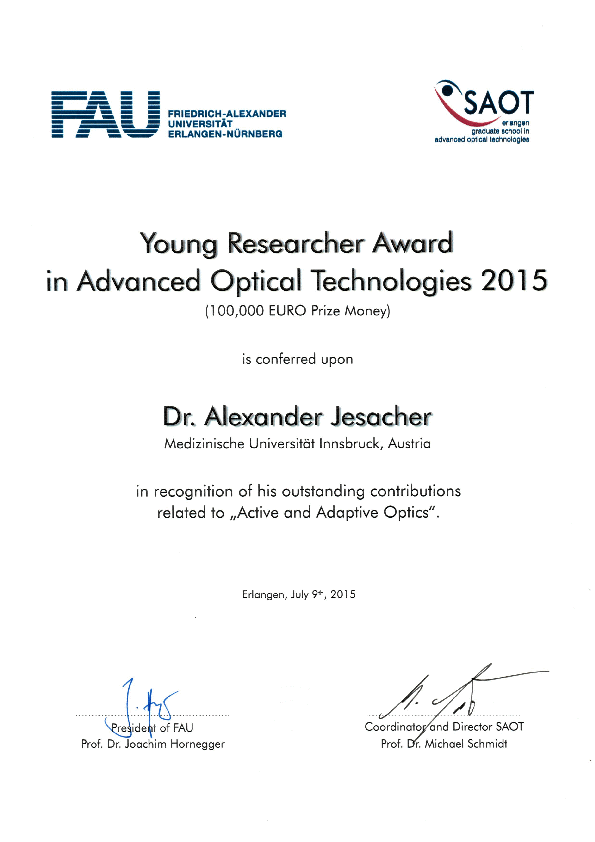
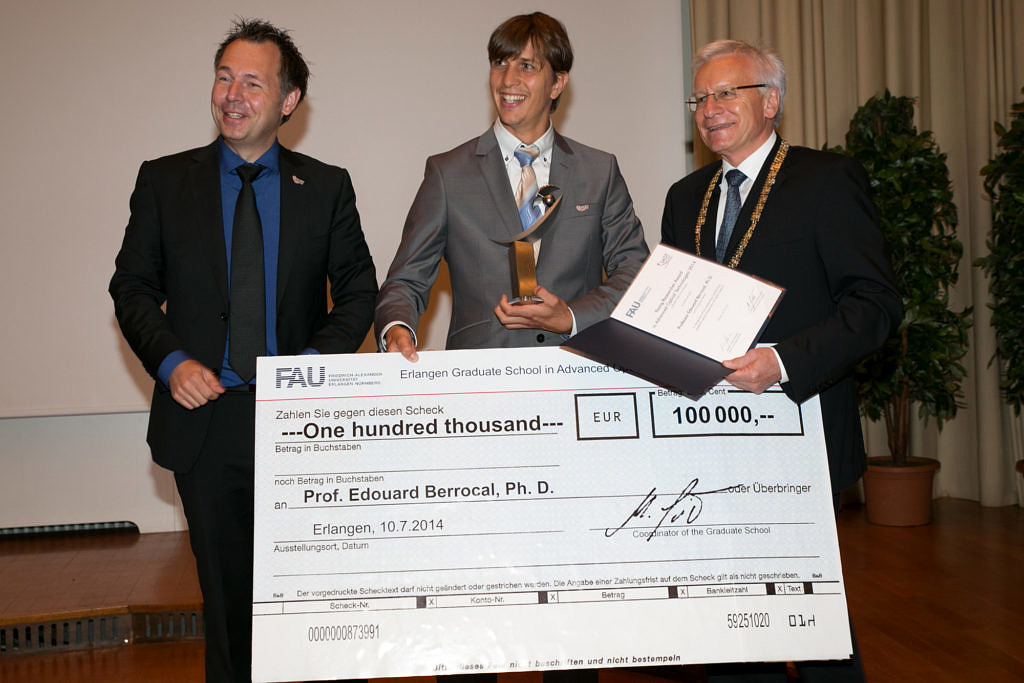
On June 10th 2014 the Erlangen Graduate School in Advanced Optical Technologies (SAOT) bestowed the seventh Young Research Award in Optical Technologies (YRA). The award of 2014 was received personally by Professor Edouard Berrocal from the Division of Combustion Physics of the Lund University, Sweden.
Prof. Dr.-Ing. Michael Schmidt, new Coordinator & Director of SAOT, welcomed Professor Berrocal, laureates from the past years and chosen guests at the beginning of the ceremony.
The lecture of the academic ceremony was given by Prof. Dr. Katharina Kohse-Höinghaus, Chair Professor Physical Chemistry at the University of Bielefeld, germany and President of the Combustion Institute in Pittsburgh, USA. The title of the lecture was “Optical Diagnostics in Combustion and Beyond”.
After a Laudatio given by Professor Schmidt, the YRA which comprises a certificate, a trophy and a € 100.000 cheque, was presented to Professor Berrocal by the President of the Friedrich-Alexander-Universität, Professor Grüske.
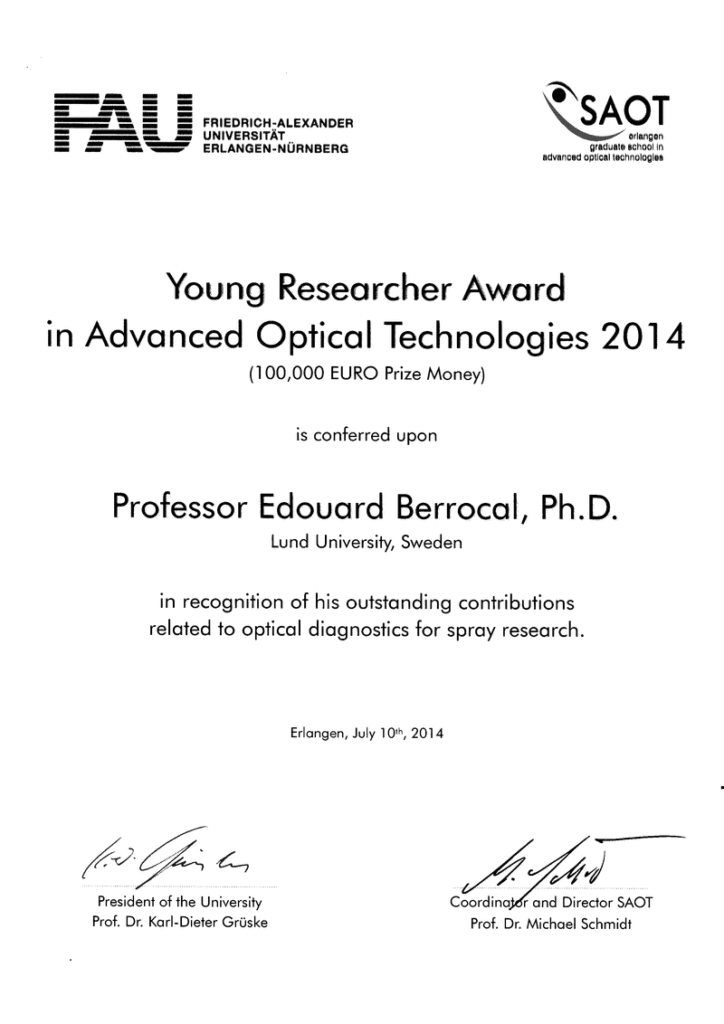
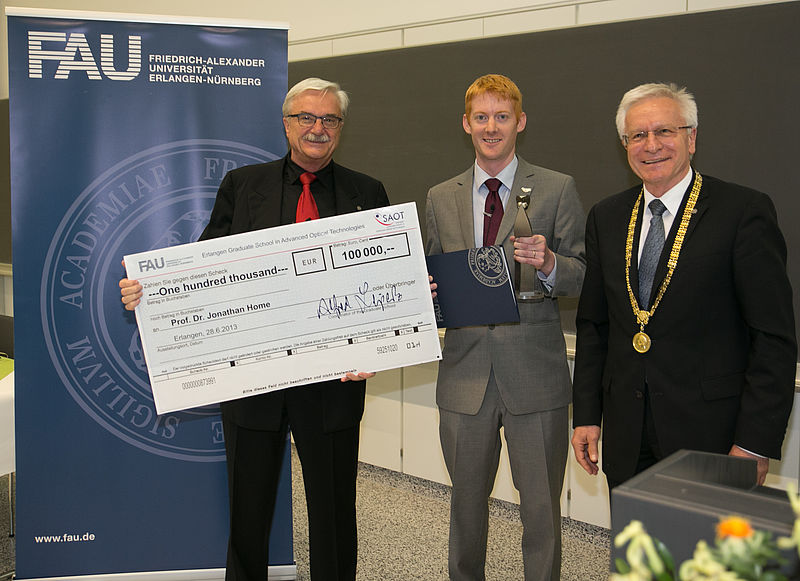
In a ceremony on 28th July 2013, the SAOT Young Researcher Award in Optical Technologies (YRA) was awarded for the sixth time. The 2013 laureate is Professor Dr. Jonathan Home, Assistant Professor of Quantum Optics and Photonics in the Department of Physics at ETH Zurich (Swiss Federal Institute of Technology Zurich).
The YRA recognizes his outstanding contributions in ion trap quantum information processing. For the next few years he will be seen on a regular basis at the Erlangen Graduate School in Advanced Optical Technologies (SAOT), where he will spend the prize money of 100,000 Euro in close collaboration with SAOT scientist. In this period he will be affiliated with the SAOT and the FAU as a guest professor.
In his welcome address the SAOT Coordinator and Director Professor Leipertz gave also a short overview about the award winners of the last years and their scientific importance for SAOT. Dr. Jonathan Home finds himself in a group of well-chosen laureates of which several were present at the ceremony.
From 2006 to 2010 Jonathan Home worked in the research group of Prof. David J. Wineland at the National Institute of Standards and Technology at Boulder, Colorado. Prof. Wineland, one of the two 2012 Nobel Laureate in Physics, presented the lecture of the ceremony with the title „Superposition, Entanglement, and Raising Schrödinger’s Cat“ in which he gave some personal insights into the work which led him to the Nobel Prize and also into the ceremony of the Nobel Prize at Stockholm last December. By this talk he gave his congratulations personally to Jonathan Home.
In the audience, consisting of nearly 150 persons from science, politics and industry, with Prof. Roy J. Glauber from Havard University a second Nobel Laureate – one of the three 2005 Nobel Laureates in Physics – was present which makes this 2013 award ceremony surely to a very unique SAOT event.
The YRA which comprises a certificate, a trophy and a € 100,000 cheque, was presented to Professor Home by the President of the Friedrich-Alexander-Universität, Professor Grüske.
In his Acknowledgement Prof. Home presented an outlook of what is to be expected of his work during the next few years in his collaboration with SAOT scientists using novel photonic crystal fiber structures to realize new types of ion traps.
After the formal end of the award ceremony, Prof. Wineland signed the Golden University Visitors´ Book.
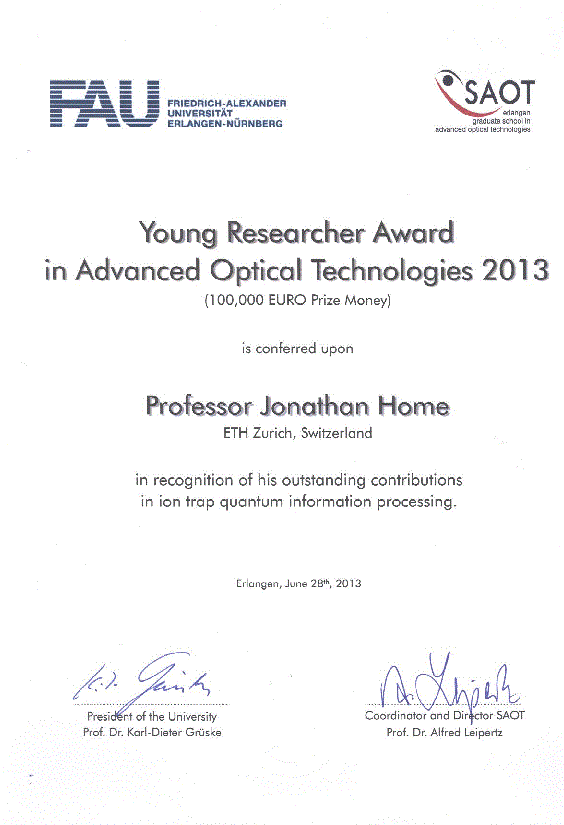
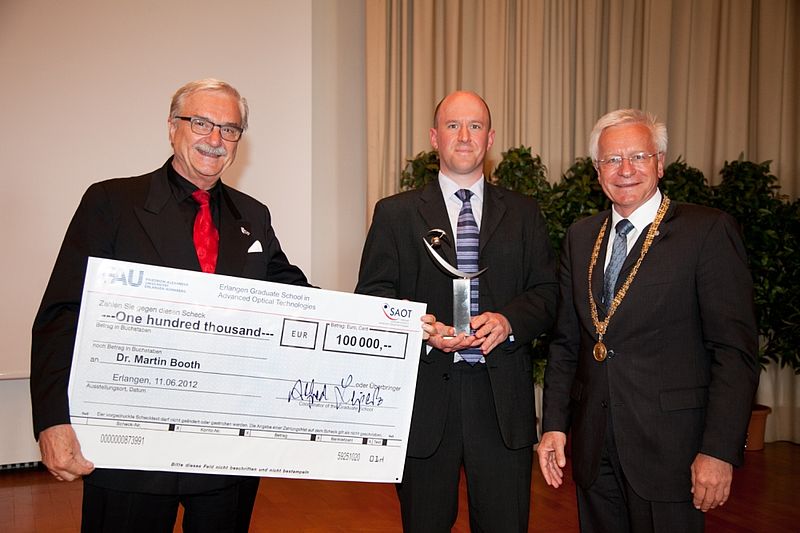
On June 11th 2012 the Erlangen Graduate School in Advanced Optical Technologies (SAOT) presented the fifth Young Researcher Award in Optical Technologies (YRA). The award is made to a young scientist with an excellent record in optics and optical technologies. It underlines SAOT’s objective to improve interdisciplinary research and education in development and application of optics and optical technologies, particularly at the interfaces between natural sciences, engineering and medicine.
This year’s laureate is Dr. Martin Booth, EPSRC (Engineering and Physical Sciences Research Council) Advanced Research Fellow in the Department of Engineering Science, University of Oxford, UK. The YRA recognizes his outstanding contributions in the application of adaptive optics to microscopy and photonic engineering. Dr. Booth’s areas of research include
- active and adaptive optics, wave front sensing and control for microscopy and optical engineering.
- high-resolution optical microscopy with applications in biomedical imaging and material characterization.
- optical micromachining and fabrication for development of photonic devices.
This expertise fits well to the SAOT research fields of optical material processing, optical materials and optical metrology. For the next few years Dr. Booth will have the formal status of a SAOT guest professor. Funded by the prize money of € 100,000 he will set up a small working group in Erlangen to pursue optical investigations in collaboration with SAOT scientists.
The commemorative speech presented by Professor Christopher Dainty, NUI Galway can be downloaded here.
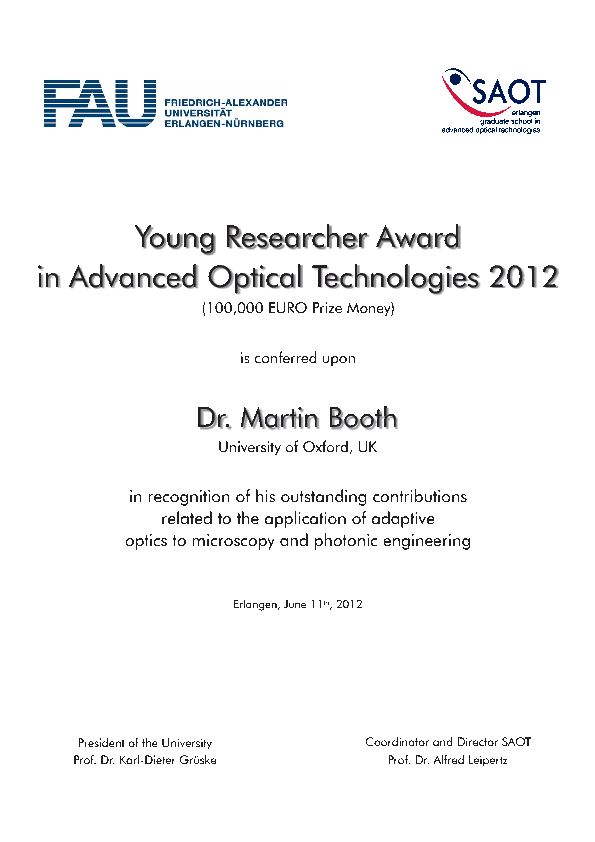
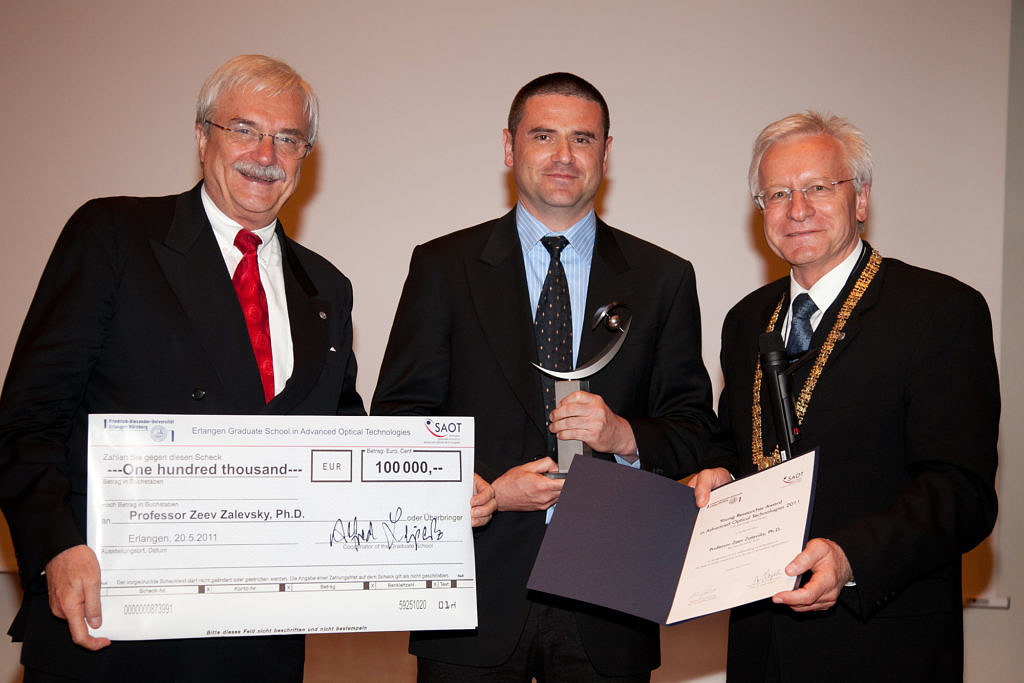
On 20th May 2011 the Erlangen Graduate School in Advanced Optical Technologies (SAOT) presented for the fourth time the “Young Researcher Award in Advanced Optical Technologies”. The 2011 laureate is Prof. Zeev Zalevsky, Associate Professor at the School of Engineering at the Bar-Ilan University, Israel, who has made outstanding contributions in the field of super resolution and its use in biomedical applications. As award winner he will have the formal status of a guest professor during his stays at the SAOT when he spends the prize money of 100,000 Euros in close collaborations with several SAOT scientists. For the next few years he will set up a small working group in Erlangen to pursue optical investigations in his area of expertise.
The award underlines SAOT’s objective to improve interdisciplinary research and education in development and application of optics and optical technologies, particularly at the interfaces between natural sciences, engineering and medicine. The Young Researcher Award in Optical Technologies strengthens the international networking of distinguished experts and provides a platform for the interdisciplinary exchange of innovative scientific ideas.
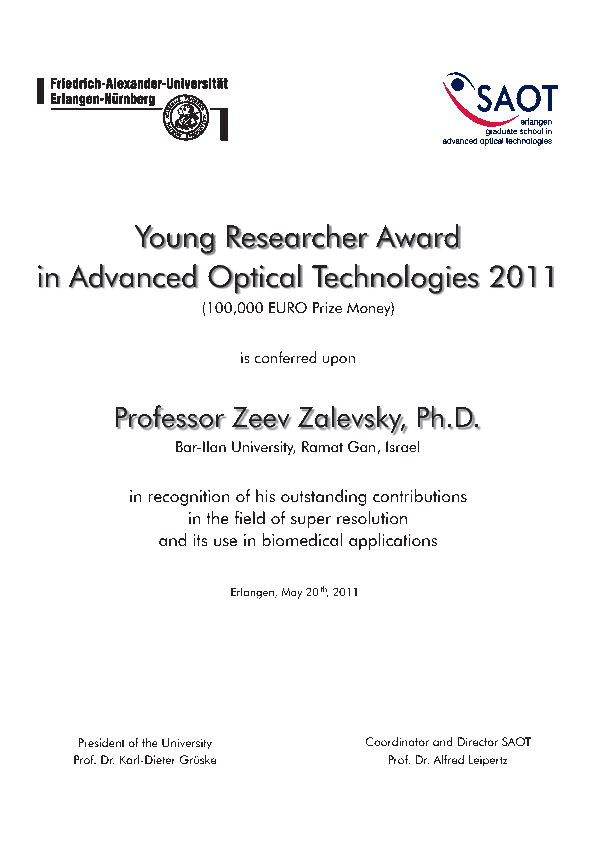
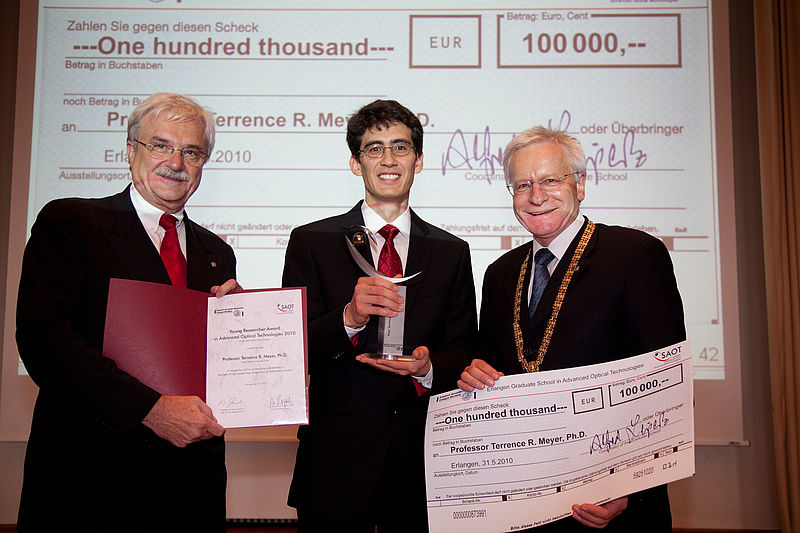
In a ceremony on 31st May 2010 the SAOT Young Researcher Award was awarded for the third time. This year’s laureate is Terrence R. Meyer, Ph.D., Assistant Professor in the Department of Mechanical Engineering and Director of the Clean Energy Technologies Program at the Iowa State University. The prize honours the outstanding contributions of Terrence Meyer to laser diagnostics in combustion published in about 40 research papers.
About 150 persons from science, politics and industry joined the award ceremony in the assembly hall of the university’s headquarters. A welcome address and a laudation were spoken by the SAOT Coordinator and Director Professor Leipertz. The ceremonial lecture was presented by Professor Andreas Tünnermann from the Friedrich-Schiller-University, Jena. The prize which comprises a certificate, a trophy and a € 100,000 cheque, was conferred to Professor Meyer by the President of the university, Professor Grüske. The prize money will fund research activities at the Friedrich-Alexander University of Erlangen-Nürnberg (FAU) during the next three to four years. During this period Professor Meyer will be affiliated with the SAOT and the FAU as a guest professor.
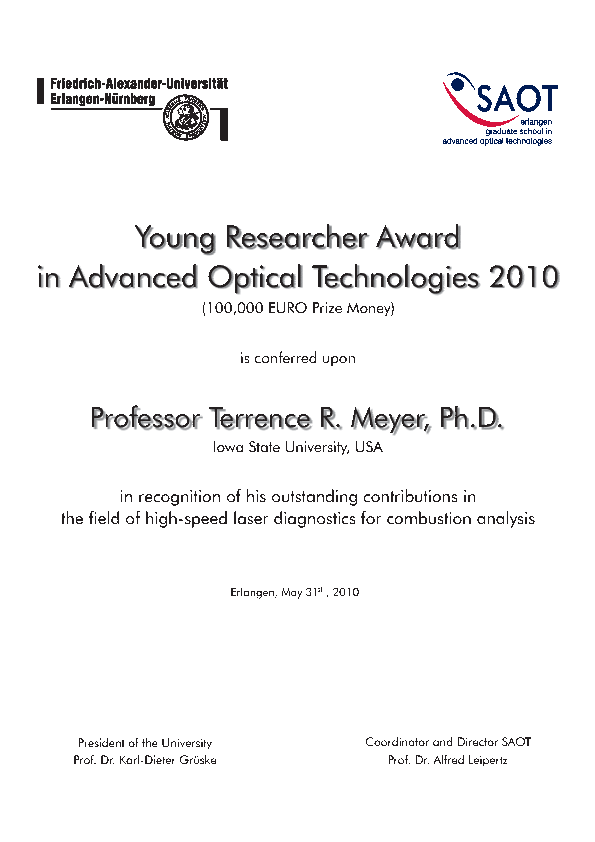
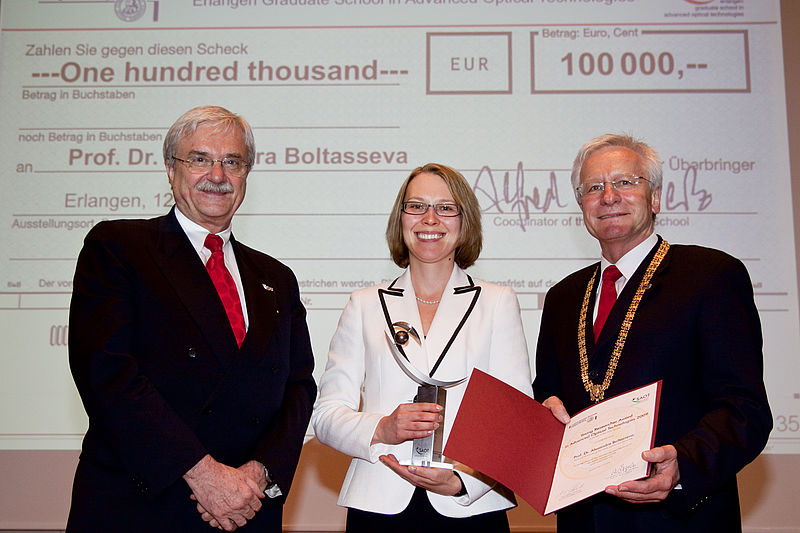
In 2009 the Erlangen Graduate School in Advanced Optical Technologies (SAOT) honors Professor Alexandra Boltasseva with the Young Researcher Award for outstanding scientific contributions of a young researcher with a proven record in Optics, Photonics and Optical Technologies. The prize money is 100,000 EURO.
Almost 150 persons from science, politics and industry joined the award ceremony in the assembly hall of University′s palace. The welcome address and the laudation were spoken by the SAOT Coordinator Professor Leipertz. The ceremony lecture was presented by Professor Vladimir Shalaev from Purdue University, USA. Afterwards the prize, which comprises a certificate, a trophy and a 100,000 Euro cheque, was conferred to Professor Boltasseva by the Rector of the University Professor Grüske. The prize money will be spend for research activities at the Friedrich-Alexander University Erlangen-Nürnberg (FAU) during the next three to four years. During this period Professor Boltasseva is affiliated with the SAOT and the FAU as a guest professor.
The 31 years old Alexandra Boltasseva is Associate Professor at Technical University of Denmark, Department of Photonic Engineering, and currently on leave of absence as an Assistant Professor of Electrical and Computer Engineering at Purdue University.
The prize honors her pioneering contributions in the fields of plasmonics and metamaterials. The main avenue of her research is advanced nanostructuring of metamaterials, specially designed, artificially created materials that can show electromagnetic properties not achievable with naturally occurring materials, with applications ranging from advanced photonics to chemical- and bio-sensors.
In her research, state-of-the-art nanofabrication tools are used to develop new methods and processes for creating novel nanophotonic components based on nanostructured metal-dielectric materials, with the aim to exploit physical phenomena related to surface plasmon polaritons, to address issues of miniaturized photonic circuitry and to develop new types of surface plasmon nano-devices for controlling optical processes at the subwavelength scale. Alexandra Boltasseva has published almost 40 research papers listed in the Science Citation Index (Web of Science).
talk by Professor Vladimir Shalaev
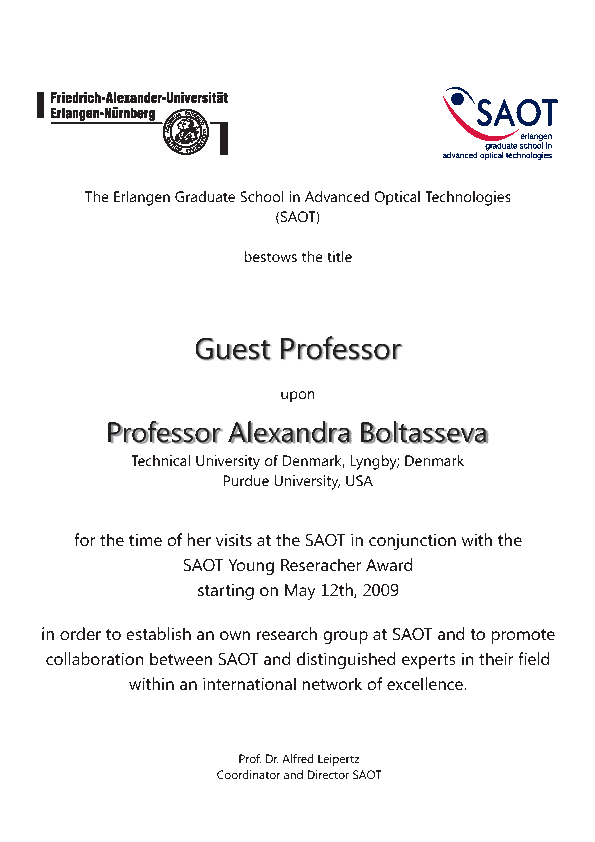
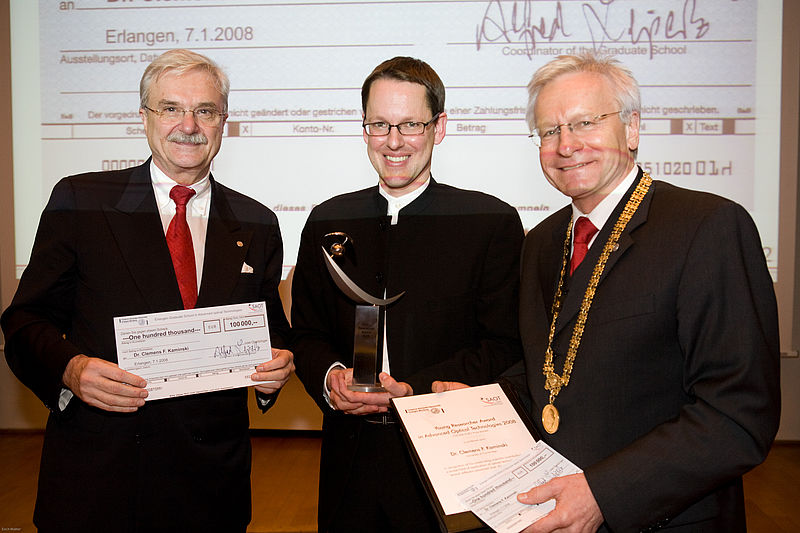
At 7th of January 2008 the Graduate School in Advanced Optical Technologies (SAOT) conferred for the first time the Young Researcher Award in Advanced Optical Technologies which is awarded with 100,000 €. The award winner was selected by the SAOT executive committee consulted by international experts in the field.
First award winner was the Austrian scientiest Dr. Clemens Kaminski from the University of Cambridge. The rector of the University of Erlangen-Nürnberg Prof. Dr. Karl-Dieter Grüske handed over the award in an academic ceremony in the auditorium of the Erlanen ’Schloss’.
The Laudation was given bei the coordinator of the SAOT Prof. Dr. Alfred Leipertz who holds a chair for Engineering Thermodynamics. Prof. Dr. Ursula Keller from the ETH Zürich gave a keynote talk about ’Generation and Application of Ultrashort Laser Pulses’.
Dr. Clemens Kaminiski is honoured for his excellent research in the field of optical technologies, particularly in the research and development of plasmas for diamond precipitation, turbolent combustion processes, spark processes and recently also for medical and biological systems. The award is combined with the position of a guest professor at the University of Erlangen-Nürnberg with in the Graduate School in Advanced Optical Technologies.
SAOT-Coordinator Prof. Leipertz says: ’The cooperation on an international level is an essential element of our graduate school. Therefore we invite scientist to Erlangen, who are leading in their field worldwide. Tey can share their knowledge with the Ph.D. students of the graduate school and can broaden it by working together with the SAOT scientists in Erlangen.’
The award winner
Dr. Clemens Kaminsik obtained his PhD in 1995 from Oxford University where he worked on the development of non linear laser techniques for the study of plasmas and flames. For his PhD work he was awarded a research fellowship by Keble college Oxford, and the Legerlotz foundation research prize.
In 1995 he moved to Marcus Aldén’s group at the Lund Institute of Technology (Sweden), where he held an EU Marie Curie fellowship and later an Associate Professorship in Engineering Physics. At Lund he pioneered techniques for the time resolved study of fast chemical processes and began extension of these techniques towards biological applications, building the foundations for the Laser Analytics group’s current research portfolio. He was appointed to his current position as a reader at Cambridge University in 2001.
He won the Cyril Hinshelwood Prize in 2004, the Gaydon Award in 2004, and the Philip Leverhulme Prize in 2005.
talk by Professor Ursula Keller
